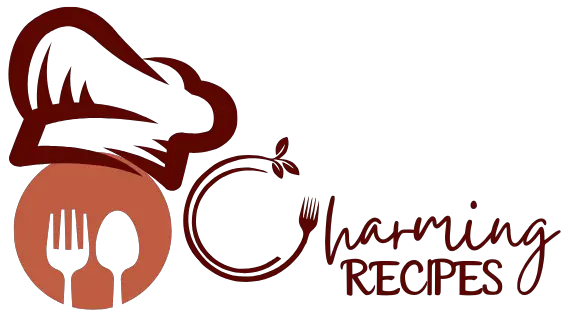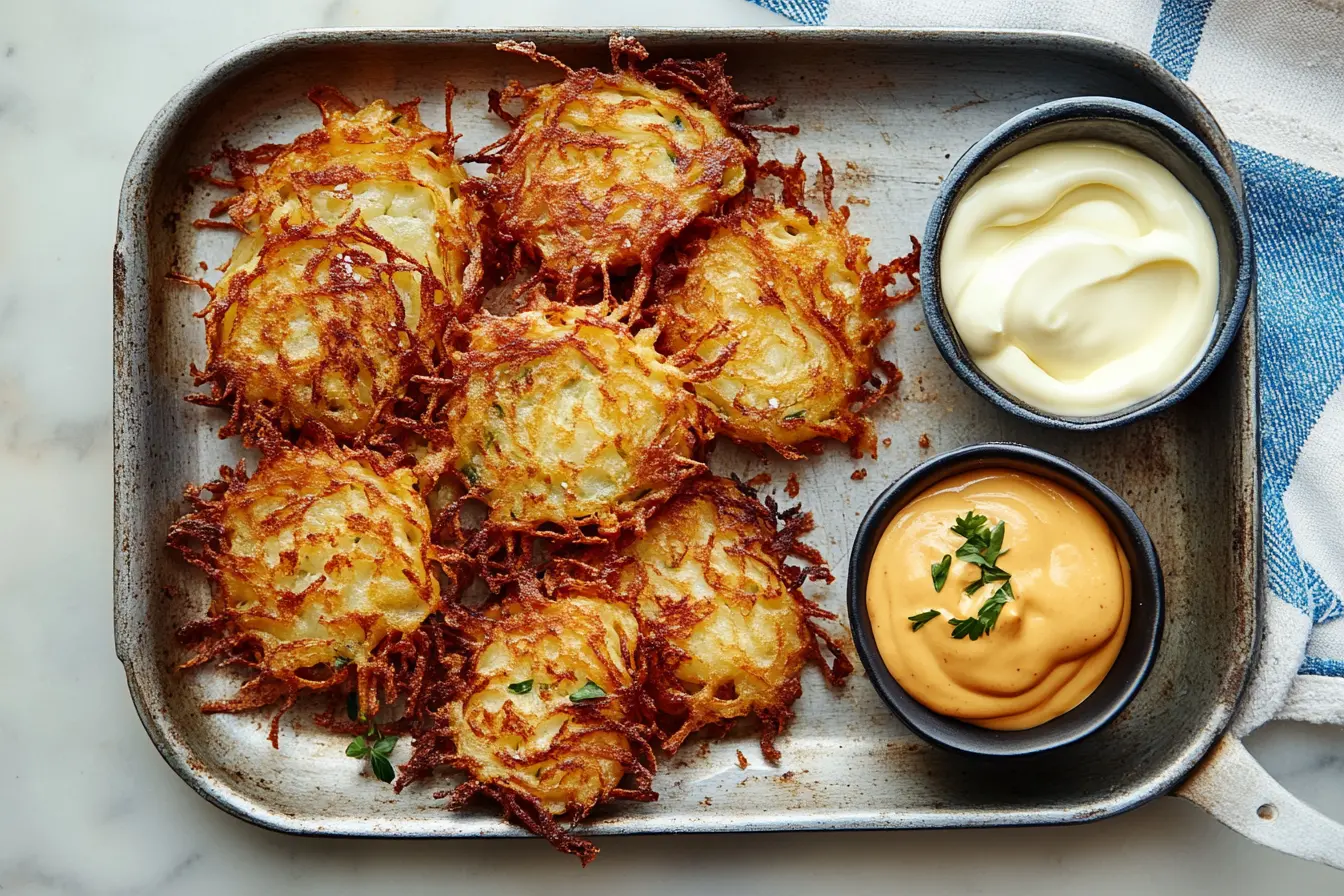Introduction
Potatoes are a universal comfort food, and some of the most beloved dishes worldwide involve this versatile ingredient. Among them, Swiss Rösti and Jewish Latkes stand out as iconic creations, each with its unique identity and cultural significance. While they may appear similar at first glance, these crispy delights have their own stories, preparation methods, and flavors that set them apart.
In this article, we’ll explore the origins, ingredients, and techniques of these two dishes. Whether you’re a food enthusiast curious about global cuisine or just someone who loves potatoes, this comparison will leave you informed and inspired.
Origins and History of Rösti and Latkes
The Historical Background of Rösti
Rösti’s Roots in Swiss Culture
Rösti, often called a Swiss potato pancake, traces its history to the farmlands of Switzerland. Initially a staple breakfast for farmers, this dish symbolized simplicity and nourishment. It’s fascinating to see how a humble recipe has become a beloved Swiss classic.
Rösti’s Rise to a Global Dish
What was once limited to Swiss households is now enjoyed in kitchens worldwide. Its adaptability and compatibility with various ingredients have made it a versatile side dish in many cuisines.
The Origins of Latkes
Latkes in Jewish Culinary Tradition
Latkes hold a special place in Jewish culture, particularly during Hanukkah. This holiday commemorates the miracle of oil, making the fried potato pancake a symbolic and meaningful dish for Jewish families.
Latkes Across Generations and Cultures
Over centuries, latkes evolved, influenced by regional flavors and ingredients. Though traditionally made with potatoes, modern latkes often incorporate vegetables like zucchini or carrots, highlighting their adaptability.
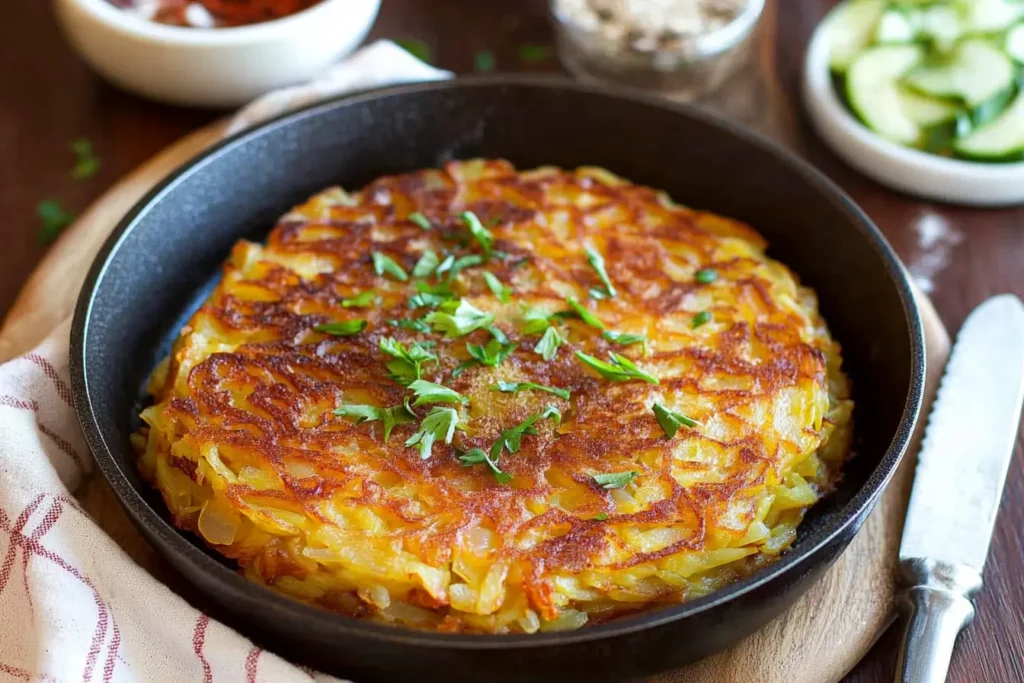
Ingredients – Similarities and Differences
Core Ingredients of Rösti
The Role of Potatoes in Rösti
At the heart of Rösti lies its simplicity, with potatoes taking center stage. Traditionally, waxy potatoes are preferred because they hold their shape during cooking, resulting in a cohesive and satisfying texture. The potatoes are often parboiled before grating, a technique that balances softness and crispiness in the final dish. Unlike other potato-based recipes, Rösti relies solely on the potato to create its iconic golden-brown crust, showcasing its natural flavor.
Optional Ingredients: Butter, Herbs, and Cheese
Though Rösti can stand alone with just potatoes, adding ingredients like butter, herbs, or cheese is common, especially in modern adaptations. Butter enhances the richness, while herbs like parsley or chives bring a fresh, aromatic touch. In some Swiss regions, Rösti includes grated cheese, which melts into the dish, creating a delightful fusion of flavors. These variations offer flexibility while maintaining the dish’s simplicity.
What Goes into Making Latkes?
Traditional Latke Ingredients: Potato, Onion, and Matzo Meal
Latkes, in contrast to Rösti, involve a few more ingredients to achieve their distinctive flavor and texture. Potatoes remain the primary component, but onions play a key role in adding depth and a hint of sweetness. A binder—commonly matzo meal or flour is used to hold the mixture together, along with eggs, which contribute to the latke’s structure and crispiness. This combination results in a patty that is not only savory but also packed with layered flavors.
Modern Variations and Additions
While the traditional latke recipe remains cherished, modern kitchens have introduced exciting twists. Sweet potatoes, zucchini, carrots, and even beets have found their way into latke recipes, offering vibrant flavors and colors. These contemporary versions cater to dietary preferences and seasonal availability while retaining the essence of the dish. Additionally, gluten-free and vegan adaptations using almond flour or flaxseed as a binder have become popular, allowing more people to enjoy this beloved treat.
A Comparison of Ingredients
Commonalities Between Rösti and Latkes
Despite their differences, Rösti and latkes share a foundational reliance on potatoes. Both dishes celebrate the versatility of this humble ingredient and achieve their signature textures through frying. They’re seasoned simply, typically with salt and pepper, allowing the natural flavors of the potato to shine.
Key Differences in Recipe Style
Where Rösti and latkes diverge is in the preparation. Rösti’s minimalistic recipe calls for just potatoes, making it a straightforward dish that highlights the ingredient’s natural taste. Latkes, on the other hand, incorporate additional elements like onions and binders, resulting in a more complex and multi-dimensional flavor. This distinction gives each dish its unique identity, catering to different tastes and culinary traditions.
Cooking Techniques – How Rösti and Latkes Are Made
Step-by-Step Guide to Making Rösti
Grating vs. Slicing Potatoes for Rösti
Rösti can be prepared using either grated or thinly sliced potatoes. In traditional Swiss recipes, parboiled potatoes are often used to achieve the perfect balance between softness and crispiness. This method helps ensure that the Rösti stays intact during frying.
Frying Techniques and Common Pitfalls
To make Rösti, potatoes are shaped into a round cake and cooked in a hot skillet with butter or oil. Patience is key here—cooking over medium heat allows the edges to crisp while the center remains tender. The most common mistake is flipping too soon, which can cause the Rösti to break apart. A spatula or plate is often used to help flip it seamlessly.
Step-by-Step Guide to Making Latkes
Preparing the Mixture and Avoiding Soggy Latkes
The key to perfect latkes lies in removing excess moisture. After grating the potatoes and onions, pressing them firmly to drain liquid is essential. Mixing the dry potato mixture with eggs, matzo meal (or flour), and seasonings creates a cohesive batter.
Frying Latkes: Tips for Crisp Perfection
Latkes are fried individually, typically in shallow oil. To ensure even frying, the oil should be hot enough to sizzle when the batter hits the pan. Flattening the latkes slightly in the skillet helps achieve a crisp texture without burning.
Contrasting the Two Methods
Rösti’s Simplicity vs. Latkes’ Complexity
Rösti’s preparation is minimalistic—ideal for those who want an uncomplicated dish. In contrast, latkes require more steps, including draining, mixing, and precise frying, making them slightly more labor-intensive.
Textural and Taste Differences in Preparation
While Rösti is a single large cake with a uniform texture, latkes have crisp edges and a soft center, offering a delightful contrast in every bite. The addition of onions in latkes gives them a more layered flavor compared to Rösti’s clean, buttery taste.
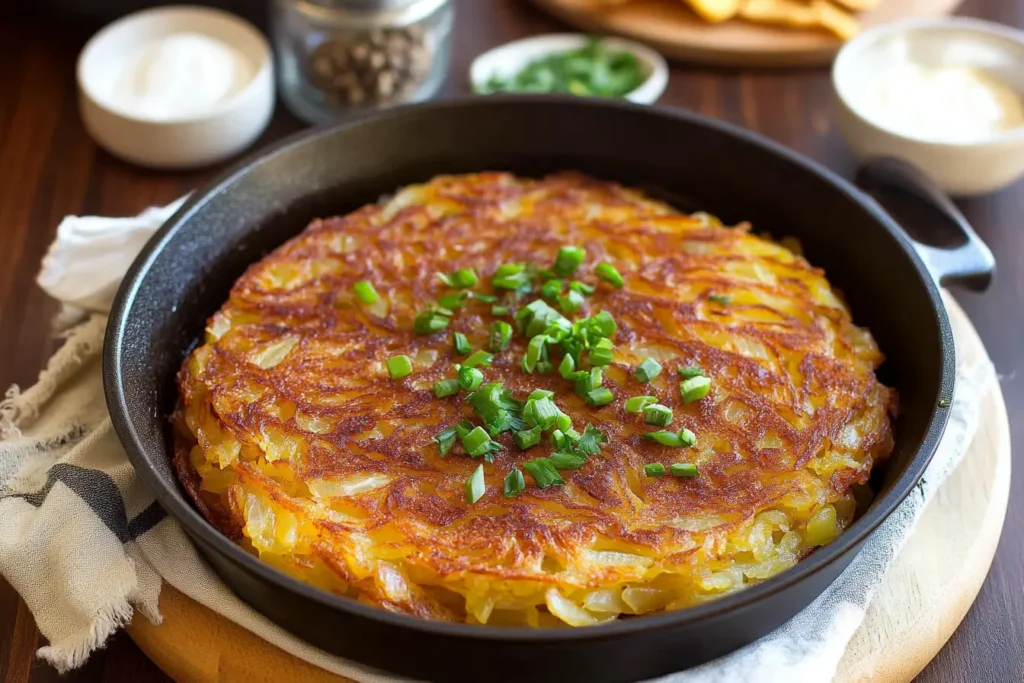
Cultural Significance and Uses
Rösti’s Role in Swiss Cuisine
As a Breakfast Dish or Side
Rösti was traditionally a farmer’s breakfast in Switzerland, providing a hearty start to the day. Over time, it has become a versatile dish served as a side to accompany meats, vegetables, or even eggs. Its simplicity allows it to pair seamlessly with a wide variety of foods, making it a staple on Swiss dining tables.
Regional Variations of Rösti in Switzerland
Different Swiss regions have their own take on Rösti. In Bern, for instance, people often include bacon and onions, while other areas might add cheese or apples for a unique twist. These variations reflect the adaptability of Rösti to local tastes and ingredients.
Latkes and Their Connection to Jewish Holidays
Symbolism of Oil in Latke Preparation
Latkes are closely tied to Hanukkah, a Jewish festival commemorating the miracle of the oil that lasted eight days. The act of frying latkes in oil is symbolic, representing the light and resilience celebrated during this holiday.
Latkes’ Role in Hanukkah Celebrations
Beyond their symbolism, latkes have become a cherished tradition at Hanukkah gatherings. Families often come together to prepare and enjoy these golden pancakes, creating bonds and memories that transcend generations.
How the Dishes Are Served Globally
Rösti in Fine Dining vs. Latkes in Family Gatherings
While Rösti often graces restaurant menus as a gourmet side dish, latkes retain their charm as a home-cooked comfort food. Latkes are typically served with accompaniments like applesauce or sour cream, enhancing their flavor, while Rösti is more commonly paired with savory items like sausages, eggs, or smoked salmon.
Nutritional Comparison and Variations
Comparing the Nutritional Profiles
Caloric Content of Rösti vs. Latkes
When comparing the two dishes, Rösti tends to be lighter in terms of added ingredients, as it often comprises just potatoes, butter, and seasoning. Latkes, on the other hand, include eggs, flour or matzo meal, and oil for frying, which can increase their calorie count. A standard serving of latkes may be higher in calories and fat due to the frying process and additional ingredients.
Differences in Fat and Carbohydrate Ratios
Both dishes are rich in carbohydrates because of the potatoes, but latkes generally contain more fat due to the eggs and frying oil. Rösti’s simpler preparation may result in a slightly healthier profile, especially if cooked with minimal fat.
Exploring Modern Variations
Healthier Takes on Rösti and Latkes
For health-conscious individuals, Rösti and latkes can be adapted to fit specific dietary needs. Rösti can be made with sweet potatoes or cooked in non-stick pans to reduce oil usage. Similarly, latkes can be baked instead of fried, significantly lowering the fat content.
Vegan and Gluten-Free Versions
Modern dietary trends have also inspired vegan and gluten-free versions of both dishes. Rösti naturally aligns with vegan diets when made without butter, while gluten-free latkes can substitute flour or matzo meal with almond flour or cornstarch. These adaptations maintain the essence of the dishes while catering to a wider audience.
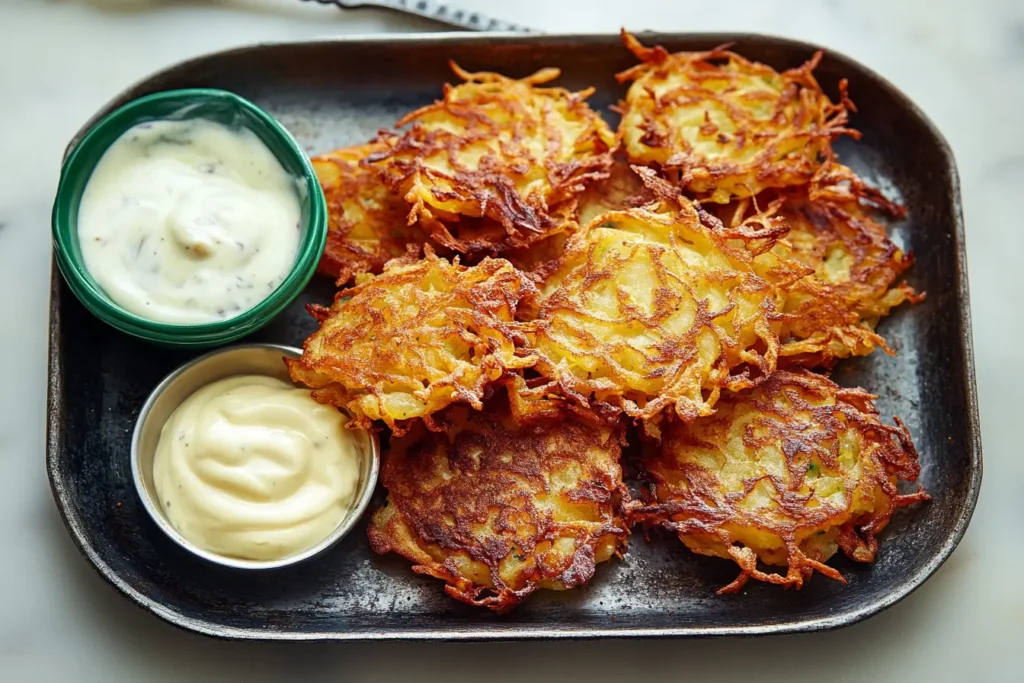
Frequently Asked Questions (FAQs)
What is the difference between latkes and German potato pancakes?
Latkes and German potato pancakes are similar but have distinct differences. Latkes are traditionally associated with Jewish cuisine and often include grated potatoes mixed with onions, eggs, and a binder like matzo meal or flour. They are typically fried and served with applesauce or sour cream. German potato pancakes, also known as Reibekuchen, are simpler, made with potatoes, onions, eggs, and a bit of flour, but without the cultural or symbolic connection.
What’s the difference between Rösti and hash browns?
Rösti and hash browns are both potato-based dishes, but they differ in preparation and texture. Rösti is a Swiss dish made with grated or thinly sliced potatoes that are often parboiled beforehand, resulting in a cohesive and cake-like texture. Hash browns, popular in the United States, are made with raw grated potatoes and are typically cooked in smaller, loose portions, giving them a crispier, less uniform texture.
Are hash browns and latkes the same?
No, hash browns and latkes are not the same, though both are made from potatoes. Hash browns are plain grated potatoes fried until crispy, without additional ingredients. Latkes, in contrast, include onions, eggs, and a binder, giving them a denser and richer flavor. Latkes are also deeply rooted in Jewish traditions, especially during Hanukkah, whereas hash browns are a standard breakfast item in American cuisine.
Is Rösti Swiss or German?
Rösti is a Swiss dish, originating from the German-speaking part of Switzerland. It was traditionally eaten as a farmer’s breakfast in the canton of Bern. While the dish has some similarities with German cuisine, its preparation and cultural significance make it distinctly Swiss.
Conclusion
While Rösti and Latkes may appear similar at a glance, they are unique dishes with distinct histories, preparation methods, and cultural significance. Rösti, with its origins in Switzerland, embodies simplicity and versatility, often served as a side dish or a meal on its own. On the other hand, Latkes carry the rich traditions of Jewish cuisine, particularly during Hanukkah, symbolizing resilience and celebration.
From their ingredients to their textures, each dish offers a unique experience. Whether you prefer the rustic, cake-like Rösti or the crispy, flavorful Latkes, both stand as testaments to the universal appeal of potatoes in global cuisine. As you savor these dishes, you’re not just enjoying a meal—you’re partaking in a rich culinary tradition that spans cultures and generations.
Explore More Delicious Recipes:
Print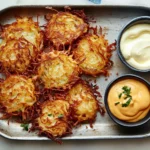
Rösti vs. Latkes: A Culinary Comparison
- Total Time: 60 minutes
- Yield: 4 servings
- Diet: Vegetarian
Description
Explore the unique flavors and histories of Swiss Rösti and Jewish Latkes, two iconic potato dishes with distinct preparation methods and cultural significance.
Ingredients
- Waxy potatoes
- Butter
- Salt
- Pepper
- Onion
- Matzo meal or flour
- Eggs
- Optional: Herbs (parsley, chives), cheese, zucchini, carrots
Instructions
- For Rösti: Parboil the waxy potatoes, then grate or thinly slice them.
- Shape grated potatoes into a cake and cook in a hot skillet with butter or oil, ensuring the edges crisp up.
- For Latkes: Grate the potatoes and onions, pressing them to remove excess moisture.
- Mix the dry mixture with eggs and matzo meal to form a batter.
- Fry individual latkes in shallow oil until crispy on both sides.
Notes
Rösti is traditionally a simple dish highlighting the potato’s natural flavors, while latkes are richer, often served with applesauce or sour cream.
- Prep Time: 20 minutes
- Cook Time: 40 minutes
- Category: Side Dish
- Method: Frying
- Cuisine: Swiss, Jewish
Nutrition
- Serving Size: 1 serving
- Calories: 300
- Sugar: 2g
- Sodium: 300mg
- Fat: 15g
- Saturated Fat: 4g
- Unsaturated Fat: 8g
- Trans Fat: 0g
- Carbohydrates: 40g
- Fiber: 4g
- Protein: 6g
- Cholesterol: 50mg
